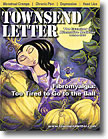


From the
Townsend Letter |
||
Recent Progress in Clinical Applications |
||
Continued. . . 1, 2, 3, 4, 5, 6, 7, 8, 9, 10, 11, 12
FUNGUS IN DISEASES OTHER THAN FIBROMYALGIA Fungus in Cancer A new treatment for fibromyalgia, proven highly successful in the Ingles Integrative Hospital Mexico, is the use of an Alkanylated Sulfur Compound administered intravenously. All patients treated have responded dramatically after one or more treatment protocols.59 See Chart 11. Candida lusitaniae fungemia was detected in 12 cancer patients at the M.D. Anderson Cancer Center (Houston, Texas) from 1988 to 1999. Four of these patients had a solid tumor, while the remaining eight were diagnosed with leukemia. The mortality rate associated with C. lusitaniae infection was 25%.87 In a surveillance study of candidiasis in cancer patients, conducted by the Invasive Fungal Infection Group of the European Organization for Research and Treatment of Cancer, 249 cases were studied. Candida albicans was isolated in 70% of the 90 cases involving patients with solid tumors and in 36% of those diagnosed with leukemia. Candida glabrata was associated with the highest mortality rate (odds ratio, 2.66:1).88 In another study of patients having solid tumors of the respiratory tract, colonization by fungi and/or yeasts was frequently found.89 Scedosporium prolificans infection was analyzed in 18 patients from
whom the fungus was isolated during the period 1990 to 1999. Six of
these patients had confirmed disseminated infection; four patients
had leukemia; and one patient had breast cancer.90 The clinical charts of cancer patients with documented fungal infections in a children's hospital in Italy from 1980 to 1990 were reviewed. Of 37 patients, ranging in age from three months to 18 years, 21 patients were treated for leukemia while 17 had solid tumors. In 40% of the cases, the fungal infection developed as primary infection, not preceded by any other infectious episode. Fungemias without evident organ localization accounted for 40% of the cases with a mortality rate of 20%. The other 22 cases (60%), nine of whom (41%) died, were classified as invasive mycoses. Mortality was highest among patients with fungal infection (72%), compared to those with only Candida yeast infections (28%) Note: Yeast is fungus.92 Aspergillus terreus developed in a patient with acute lymphoblastic leukemia following chemotherapy. A. terreus is one of the invasive Aspergillus species.93 Systemic infections related to fluconazole-resistant fungus (yeast) are increasingly observed in immunocompromised patients receiving fluconazole as an antifungal treatment. A single case of invasive candidiasis was caused by Candida ciferrii in a patient with acute myeloid leukemia. Until now, C. ciferrii has not been known to cause invasive fungal infections in humans.94 Fusarium species are fungi that attack most grains, including corn, wheat, rice, barley, and others in the field before harvest. A single case of disseminated fungal infection caused by Fusarium was reported in an immunosuppressed patient suffering from acute lymphobastic leukemia. This report and a review of recent literature suggests that Fusarium species are emerging fungal pathogens in immunosuppressed patients.95 In a second report, Fusarium moniliforme was isolated from blood culture of a six-month-old infant who had infantile leukemia and whose family raised livestock.96 Fungus in Arthritis Cryptococcus neoformans infection generally is rare, particularly in the hand. Another report describes the case of a 50-year-old patient with C. neoformans infection in his hand. 98 A case of arthritis from coccidioidomycosis in a 62-year-old man is described. The diagnosis was made by fine-needle aspiration and confirmed by positive cultures and antigen testing. Coccidioidomycosis can infect bones and joints, especially the knee which was the site of infection in this case. 99 In another case, a patient developed osteoarthritis of an ankle, due to infection by Neocosmospora vasinfecta (Ascomycete group of fungi) caused by accidental multiple trauma to his legs while in Africa. Parenteral antifungal therapy failed, and amputation was required.100 A case of arthritis of the right wrist caused by Aspergillus fumigatus without evidence of a generalized infection is described, following chemotherapy for acute lymphoblastic leukemia. The diagnosis was made by surgical biopsy. Oral itraconazole was given, and the arthritis improved.101 Another report describes a patient with polyarthritis (four separate sites) occurring over a period of several years caused by Candida lambica, probably acquired from a contaminated wound. C. lambica has not been previously reported to cause infectious arthritis. Chronic alcoholism was the only apparent risk factor for dissemination.102 Prostaglandin Production by Pathogenic Fungi Pulmonary Aspergillosis in AIDS Patients Dissemination to other organs occurred in at least two patients, and direct invasion of extrapulmonary sites was seen in two others. It was concluded that pulmonary aspergillosis is a possible late complication of AIDS.104 Mucor Cerebral Aneurysm Rupture
|
||
![]()
Consult your doctor before using any of the treatments found within this site.
![]()
Subscriptions are available for Townsend Letter, the Examiner of Alternative Medicine magazine, which is published 10 times each year.
Search our pre-2001
archives for further information. Older issues of the printed magazine
are also indexed for your convenience.
1983-2001
indices ; recent indices
Once you find the magazines you'd like to order, please use our convenient form, e-mail subscriptions@townsendletter.com, or call 360.385.6021 (PST).

All rights reserved.
Web site by Sandy Hershelman Designs
